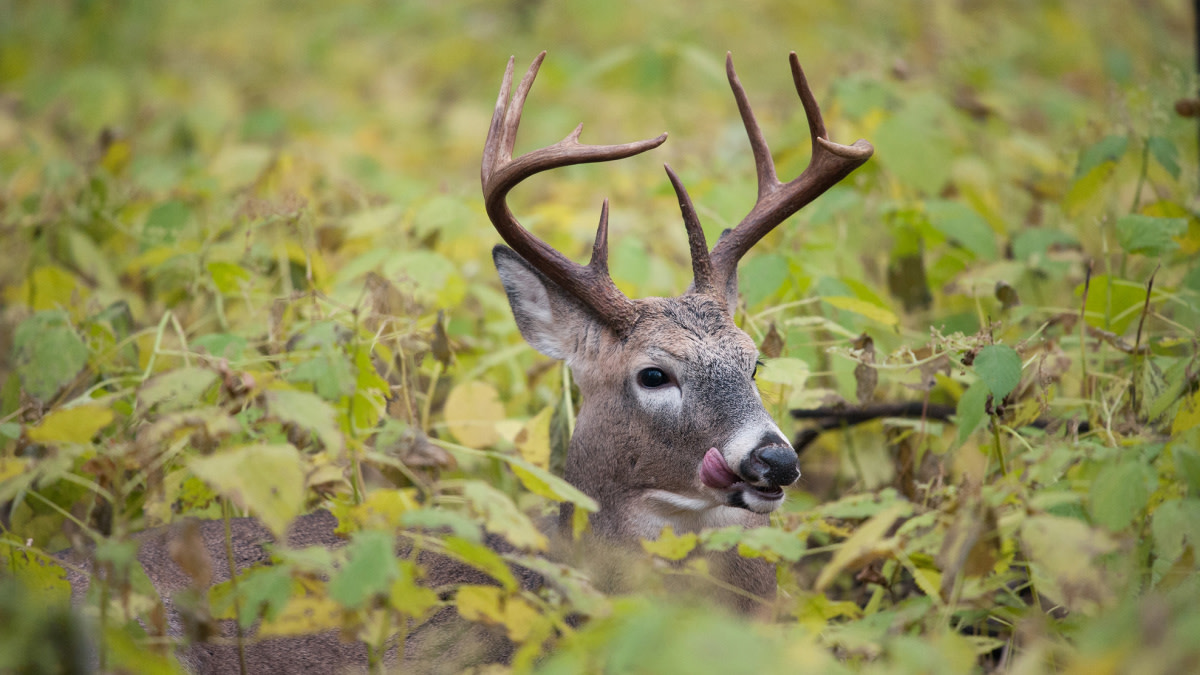
Whitetail hunters often think of food sources in a way that doesn’t do the deer’s adaptability justice. More often than not, this involves a serious focus on agricultural fields or food plots. Everyone knows deer love a picked cornfield or lush food plot full of clover, but what if you don’t have access no-brainer destination food sources?
Or, what if you’re a public land bowhunter and have no-brainer food sources, but every corner of every field has a treestand? You have to dig a little deeper into the deer menu to find preferred foods that aren’t so obvious.
Michigan’s Kevin Vistisen is a dedicated public land bowhunter and host of the Deer Hunter Podcast. When it comes to figuring out where to slip in and hunt, especially in October, he looks for a specific kind of foliage that many hunters ignore.
“I love when maple leaves hit the ground,” Vistisen said. “The deer will vacuum them up like candy. It’s best to find an isolated maple within cover if you want to experience daylight action.”
This is the kind of pattern your competition will probably miss because it involves an eye toward changing conditions. If you like hunting acorns after a cold snap brings windy conditions to shake the nuts loose from trees, do the same thing for maple leaves.
If you see a doe or small buck that you’re not going to arrow, pay attention to what they’re eating. You might realize that their movements aren’t random, and the bright yellow or red leaves they keep scooping up are not happenstance browse.
Vistisen also loves clear cuts in the big woods and hunts them like Midwest whitetailers hunt food plots. “When it comes to clear cuts, the newer the better in my experience,” Vistisen said. “The deer will work through while picking the tops off the freshest growth.”
While they don’t offer one simple food source, clear cuts offer a variety of browse and security cover that are relevant all season. Having that sense of safety is as important to public land bucks as the type of dinner they are focused on.
Earlier this season I was posted up on a public land bluff as the sun rose over the hardwoods of central Iowa. In what was the single most action-packed early October hunt I’ve ever had, I watched six bucks and a handful of does work their way back to bed. Each one of them stopped in a small meadow to feed before moving on and, after I climbed down, I had to see what they were focused on.
Vibrant green patches of clover were tucked into the waist-high yellow grass. Even though they had nearby alfalfa, beans, and corn to feed on, those bucks were all spending daylight in a secluded, sumac-dotted meadow eating volunteer clover that I had no clue was right in front of me.
Later, I hung a set in a riverbottom and watched over a dozen does and fawns slowly feed back and forth in a 10-acre patch of timber that was filled with bright green nettles. The browse pressure in there was incredible, even though they were a short walk from several ag fields.
The entire day was a good reminder that whitetails have a lot of options when it comes to filling their bellies. According to research conducted at the University of Missouri Extension, at least 600 different plants are on the whitetail’s menu in the Show-Me State alone. Damn near everything their hooves touch is edible, so keep that in mind as you walk through the woods.
The here-today-gone-tomorrow nature of the deer’s diet is most obvious with soft and hard mast, and both deserve a hunter’s attention. You shouldn’t ignore the right persimmon tree or the white oak that is hell-bent on raining down a couple hundred pounds of acorns in a given week.
But deer will also eat everything from brambles and beggar’s lice to mushrooms and poison ivy. Their ability to eat hundreds of different plants means you must keep an open mind when hunting. We all know to look for obvious sign like rubs and scrapes, but what about the soft edge in the woods where most plants are nipped off and there’s a ton of scat?
An area like this might not boast tons of thigh-sized rubs due to its fleeting nature, but it could be the one spot in the woods where you can catch a good buck on his feet. Meanwhile, other hunters will be sitting field edges watching blue jays and squirrels.
This is the key to success, because if you’re a public land hunter, you don’t necessarily have to beat the deer at their own game as much as you have to out-hunt the competition. That might simply boil down to figuring out a sneaky food source that the rest of the two-legged predators don’t even know exists.
Feature image via Matt Hansen.






